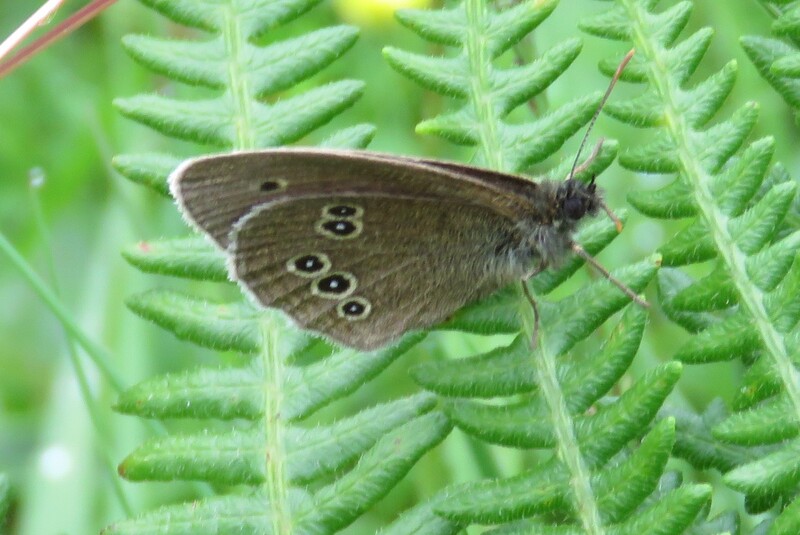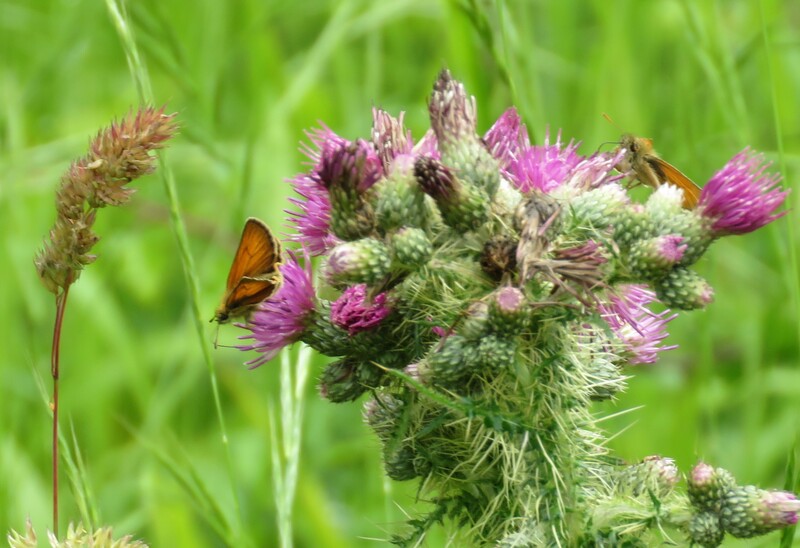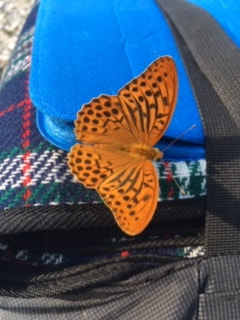 A fresh Small Skipper
A fresh Small Skipper My destination of the day is not named on the OS map. Our butterfly field-trip is timed for silver washed fritillary. Its peak flight-time is imminent and hemp agrimony, a favoured nectar plant, will soon be in bloom. The silver washed fritillary likes a sunny day. The forecast is for high humidity with an 84% chance of rain! So unpromising.
Chris talks to us about habitat. A bank of hazel at the same height shows this has been coppiced in the past. Woods have been coppiced from medieval times but coppicing with a focus on butterfly conservation is much more recent. As habitat is degraded and lost, as species disappear, it’s vital.
Wild places. Where the wild things are, wild and seldom seen. The air is moisture-laden when sunlight pours down upon a glade with the honey-fragrance of lady’s bedstraw and with marsh thistle. The perfect place and Chris calls silver washed fritillary, a bright male, the largest he’s ever seen. The butterfly alights on a bramble flower but does not linger. There are common blue, ringlets, large skipper and small skipper as a burst of sunlight brings forth butterflies. Flying up into the trees, that will be speckled wood because ringlet and meadow brown keep low. Too far off for even Chris to see but he knows how a species behaves.
On a good day, when hemp agrimony is offering nectar and the sun is bright Chris tells us there could be some twelve to twenty silver washed fritillaries about. Does a good day mean all day, I ask. We glimpse the butterfly in the shadowy woodland fringe, rapid in flight. across a ride and high over hazel. Seeing silver washed fritillary in flight is a start but my quest is more ambitious.
There are only a handful of us on this butterfly field-trip, all naturalists or active in butterfly conservation. Lynne speaks with nostalgia of Alpine butterflies, of abundance lost. Our sense of wild places includes abundance. Failure to thrive speaks of the Anthropocene, the adverse impact of man on nature.
My theme comes from a review of Robert McFarlane’s ‘ The Wild Places’ in the London Review of Books, written by Kathleen Jamie. She challenges his take on ‘ wild places’ in a lively and thought-provoking essay. I admire McFarlane’s writing but I find it excludes. He erects a barrier between himself and his reader. Jamie dubs him ‘ the lone enraptured male.’ Venturesome in a way few will aspire to or attain. He writes well but has a habit of introducing words so arcane the two-volume Shorter Oxford dictionary doesn't recognise them.
The concept of wild touches us all so here's the link to Kathleen Jamie's review.
https://www.lrb.co.uk/the-paper/v30/n05/kathleen-jamie/a-lone-enraptured-male
I had been on a butterfly field-trip on Whitbarrow in heavy rain, in the forlorn hope of finding silver washed fritillary. Home again, my email inbox had a surprise and a strange coincidence.
Here's the story.
'I was in the Julian Alps in extreme south eastern Italian Alps on the border of Slovenia
the stunning Altiplano del Montasio high above the tiny ski resort of Sella Nevea under the watchful towers of Cima Verde and its via ferrata route which was my goal for that particularly sunny and memorable day two years ago
I parked up overnight and ascended the scenic altiplano surrounded by soaring dolomitic limestone towers above and carpets of alpine flowers at my feet
after two hours I reached the base of the via ferrata route and changed into my alpine bod harness and whilst doing so removed my boots and sweaty socks to give my hot feet a breather and
then butterflies descended in their droves ....;
What are these butterflies, he asked? I had spent the day seeking them, without success, and they’d sought him out, unbidden. A horde of silver washed fritillaries from wild places,
My quest is not done yet. I seek good sightings and decent photographs. The lure is bright sun and sweaty socks. I think of the male silver washed fritillary as a 4 x 4: large, with four androconial streaks on the fore-wing. In nuptial flight, the male sprays pheromones from these adroconial streaks to entice the female. The butterfly needs to ingest minerals to make pheromones (mineral salts from sweaty socks.)










 RSS Feed
RSS Feed